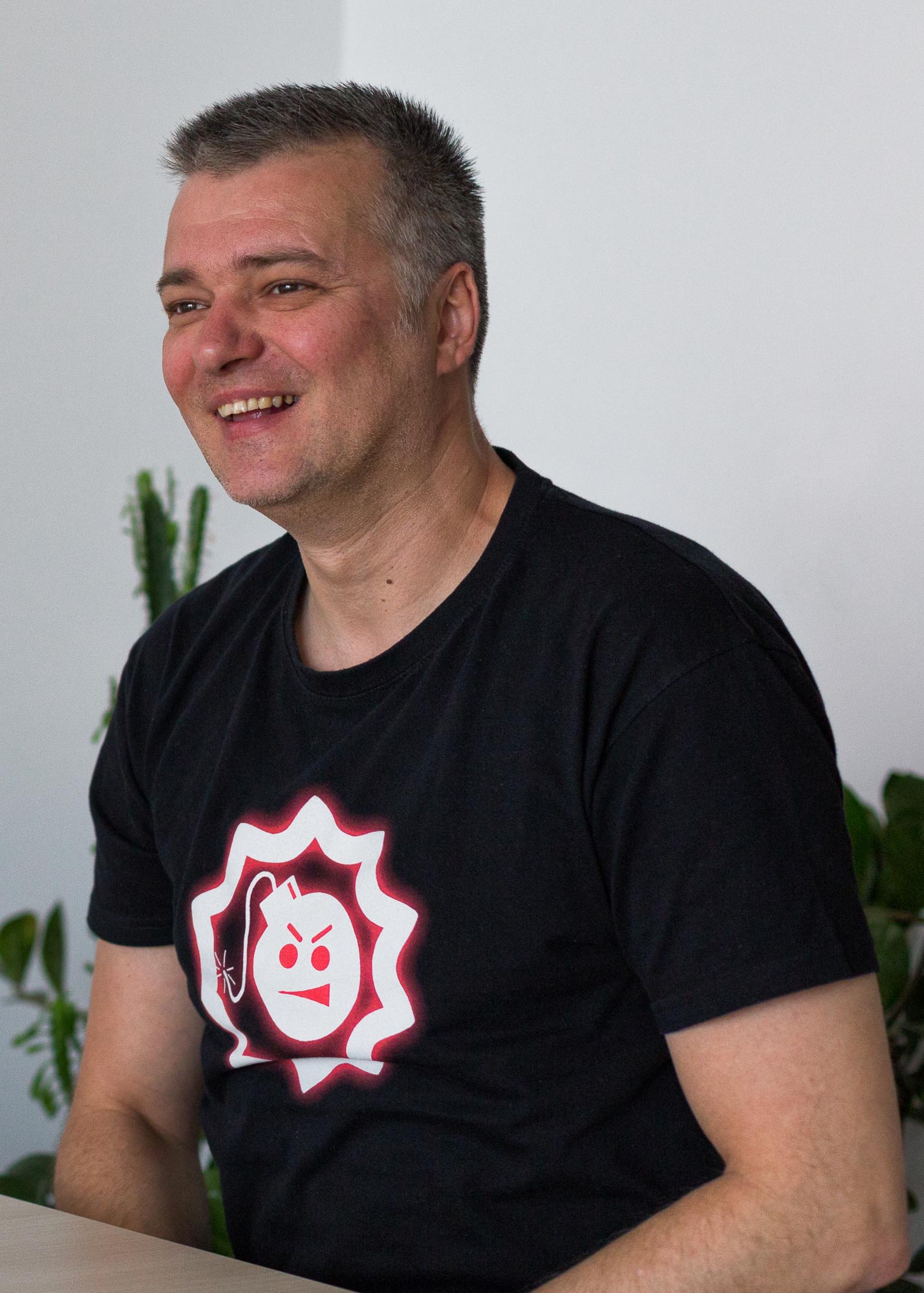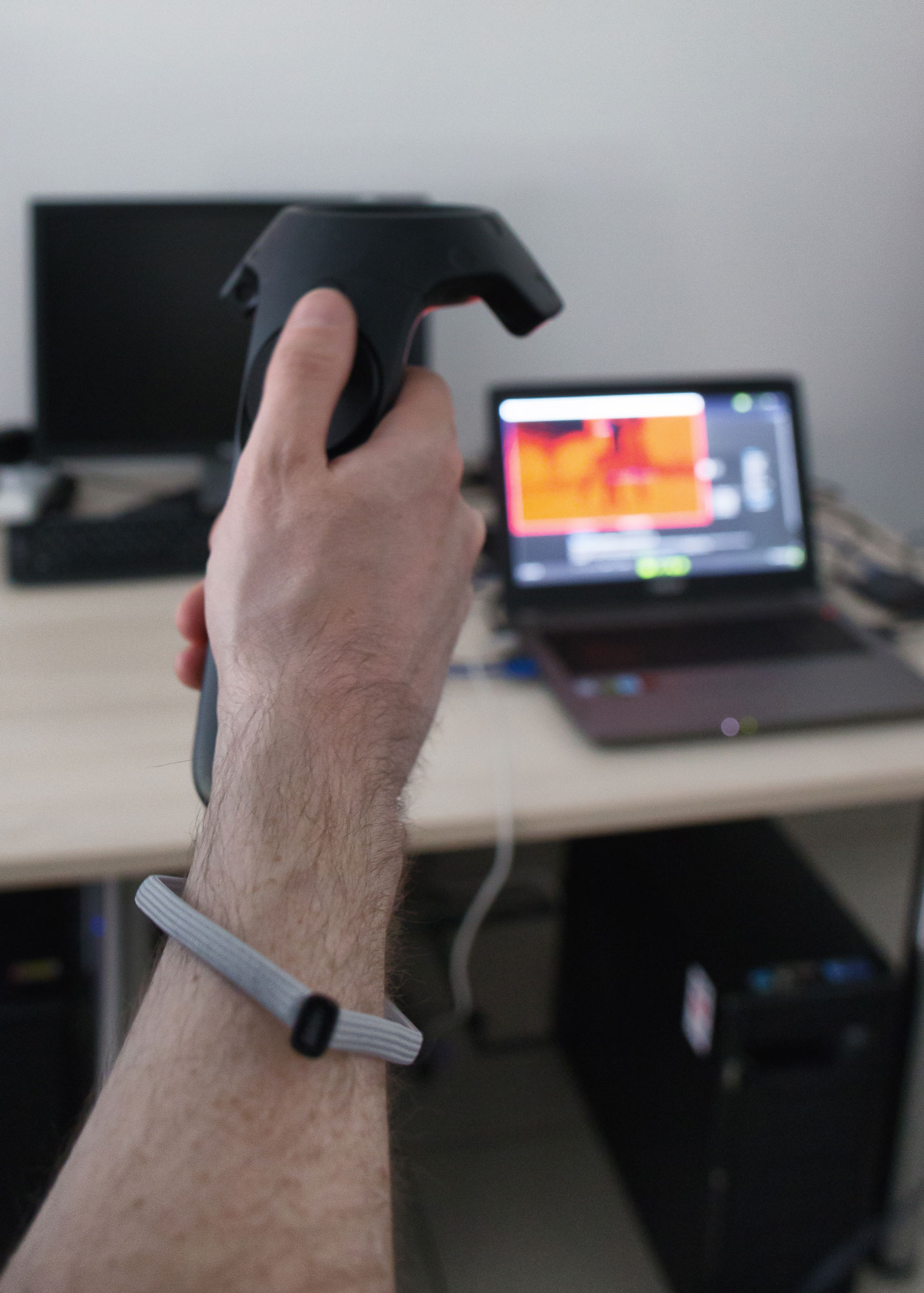Inside Croteam, the game studio going all-in on virtual reality
Cross the Sava river dividing Croatia’s capital city, and you’ll find the country’s oldest and most renowned game studio: Croteam. Their mid-rise office building is tucked among the blocky and brutalist post-WWII architecture for which Novi Zagreb, or “New Zagreb,” is known. You’d almost miss it entirely if it weren’t for the bright red logo just inside the lobby.
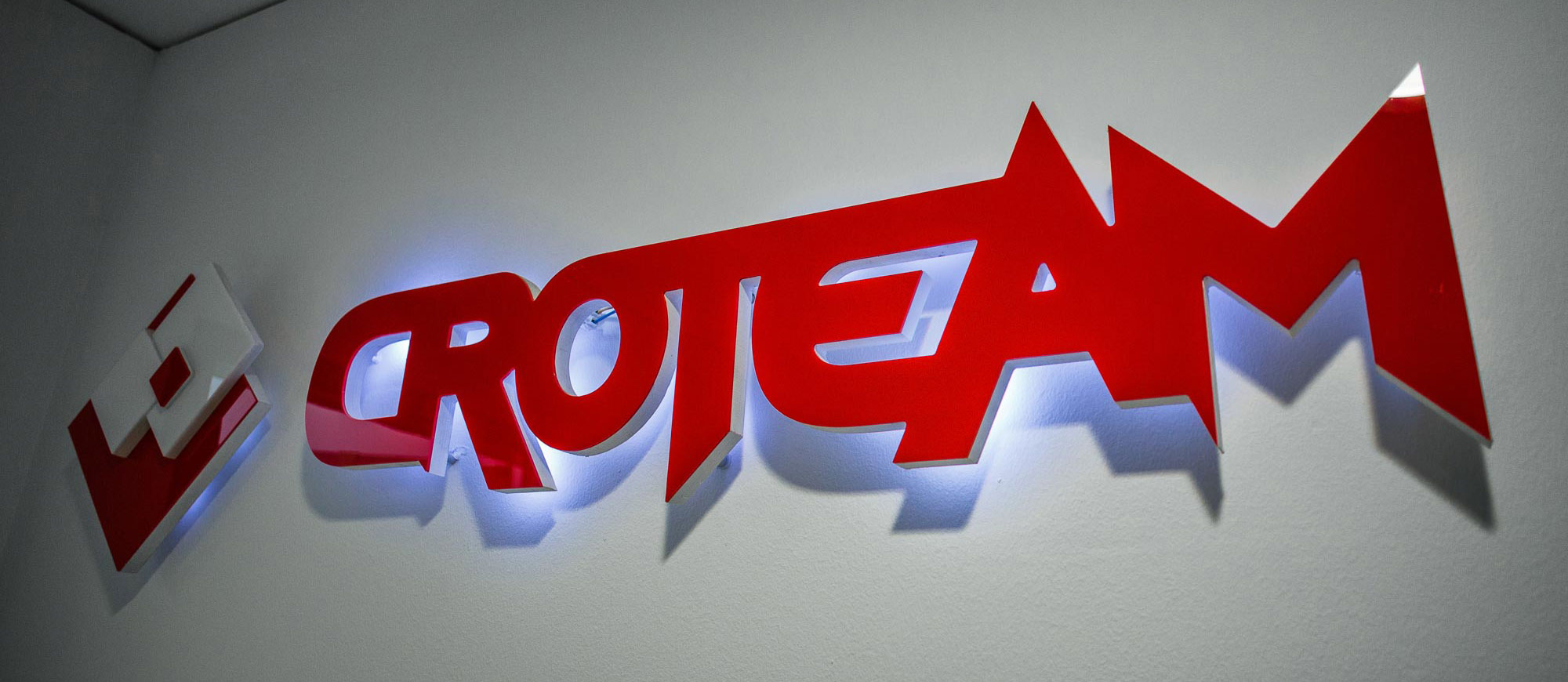 A sign you're in the right place.
A sign you're in the right place.
It’s here that they’ve dedicated two separate floors to game development and incubation, including an almost-unprecedented focus on virtual reality. But, well-regarded as they are, Croteam is still completely indie. Up until recently, they had just 20-something employees. They’ve quickly grown to nearly 60, though nobody seems to know the exact number. A lot has changed lately; even moving to this relatively modern building is a fairly recent development.
Like the Communistic buildings that now surround it, Croteam is a studio with serious lasting power. 24 years ago, they began in the most humble of ways: six long-time friends decided to create Football Glory, an Amiga-based soccer game, from their college apartment. Since then, and often fueled only by passion, they’ve survived war, endless bureaucracy, cultural stigma, and a virtually-nonexistent Croatian game dev scene.
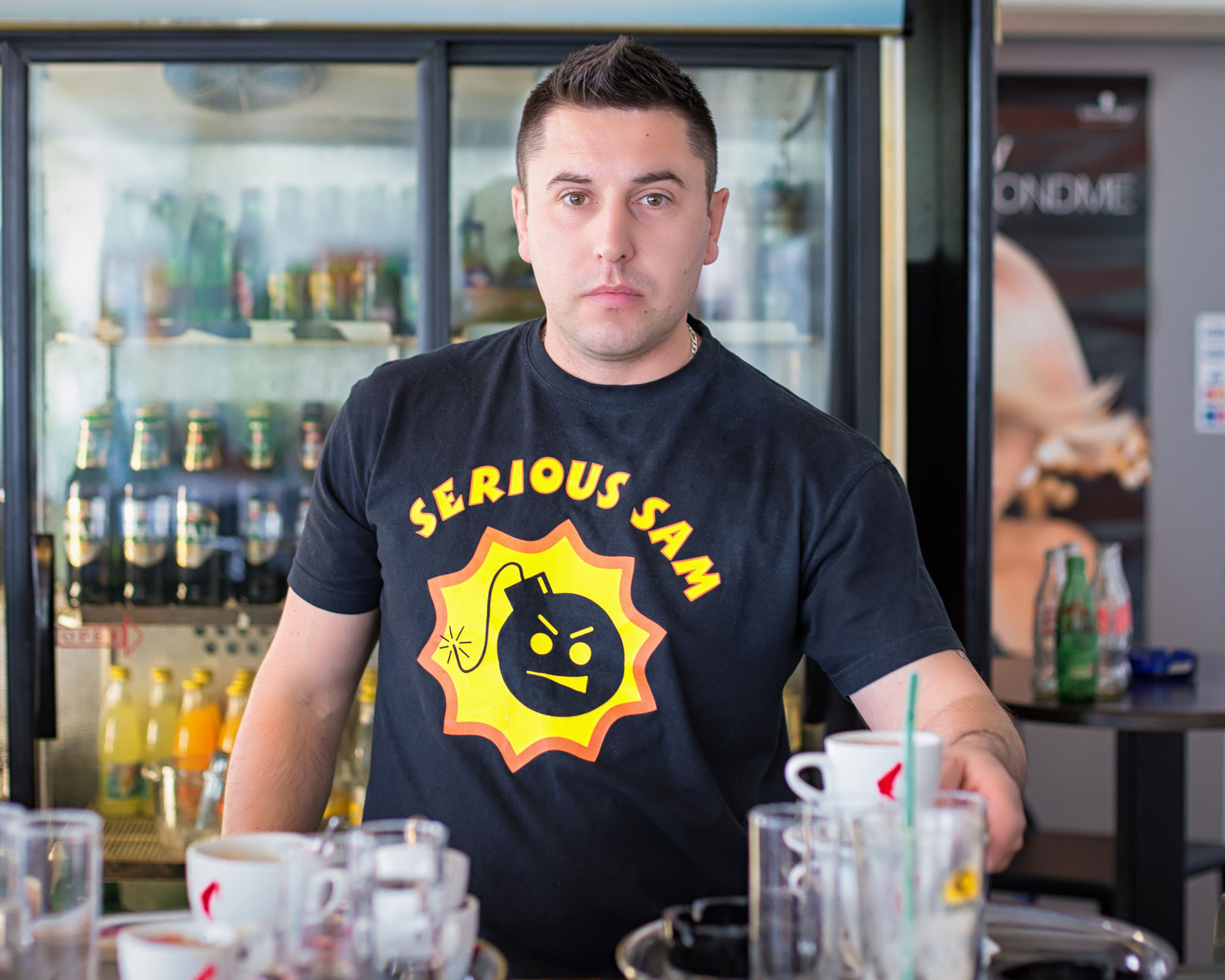 From “garage games” to now, Croteam has come a long way since their days of college apartment game development. These days, even servers in local cafes show their love for Serious Sam.
From “garage games” to now, Croteam has come a long way since their days of college apartment game development. These days, even servers in local cafes show their love for Serious Sam.
Beyond acknowledging pure grit and raw talent, Croteam seems a bit mystified by their own success. From the outside looking in, however, the answer seems clear: a refusal to be pigeonholed and a willingness to take risks. By the late nineties, they’d already dabbled in multiple genres, including sports and children’s games. In the early aughts, they released the critically acclaimed first installments of the frenetic science-fiction shooter, Serious Sam. And in 2014, after dedicating almost 13 years to the Serious Sam franchise, they switched it up again with The Talos Principle: a first-person puzzler described by IGN as a “Portal-meets-Plato thinker’s game.”
Many were taken aback by Croteam’s intellectual detour. But, then again, they’d defied expectations multiple times before. “I think many people thought we just make Serious Sam—[that] everybody [here] just likes blood, and we’re kind of dumb,” Recalls Nikola Mosettig, the VP and CIO heading up Croteam’s new indie incubation division. “You’d be amazed at how many people thought this was unnatural for us. Why would that be? I mean, if you can make a really advanced graphics engine, why wouldn’t you be able to make a nice puzzle game?”
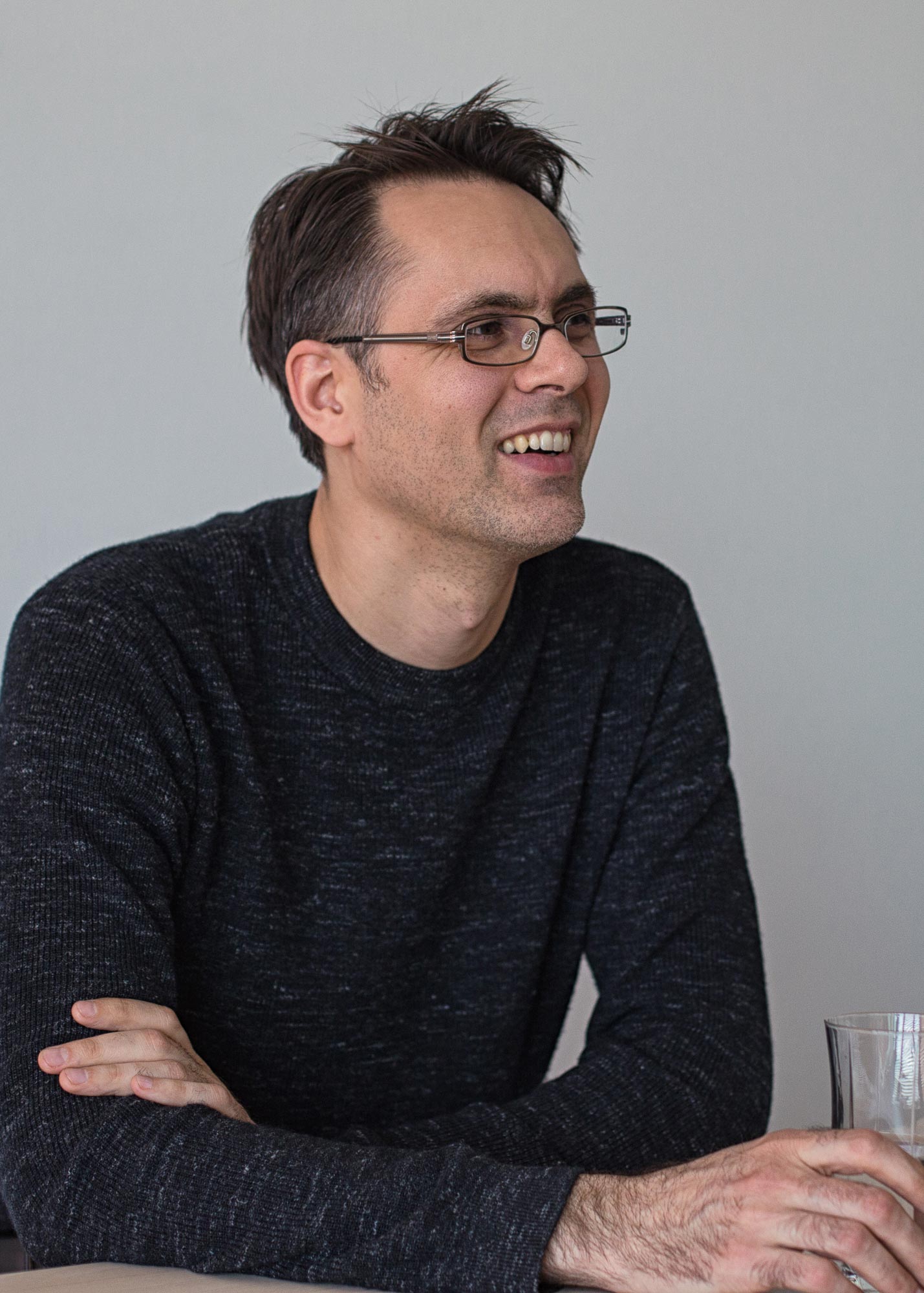 Nikola Mosettig remembers how people were surprised by The Talos Principle
Nikola Mosettig remembers how people were surprised by The Talos Principle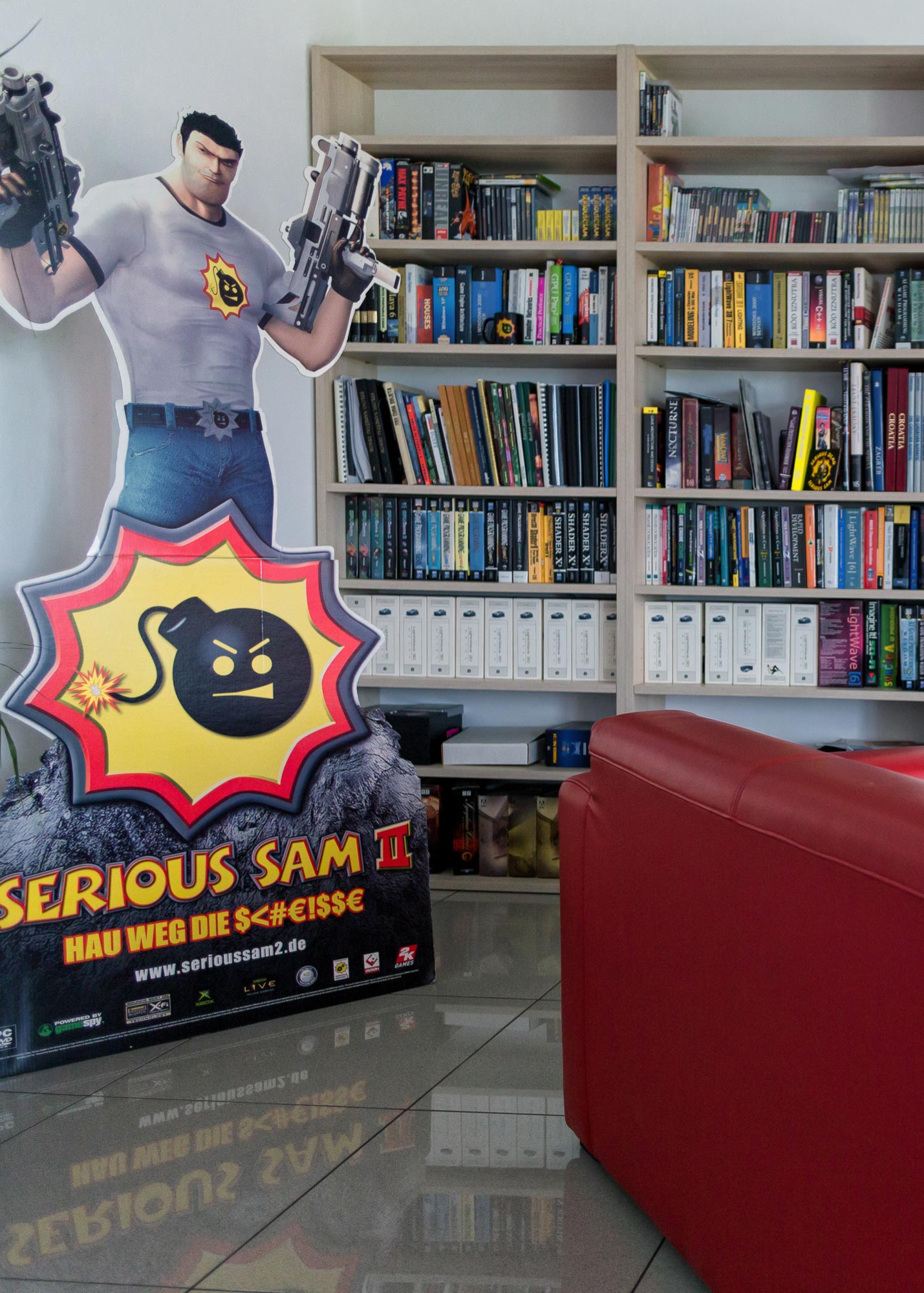 Serious Sam-themed decor is everywhere at Croteam’s offices
Serious Sam-themed decor is everywhere at Croteam’s offices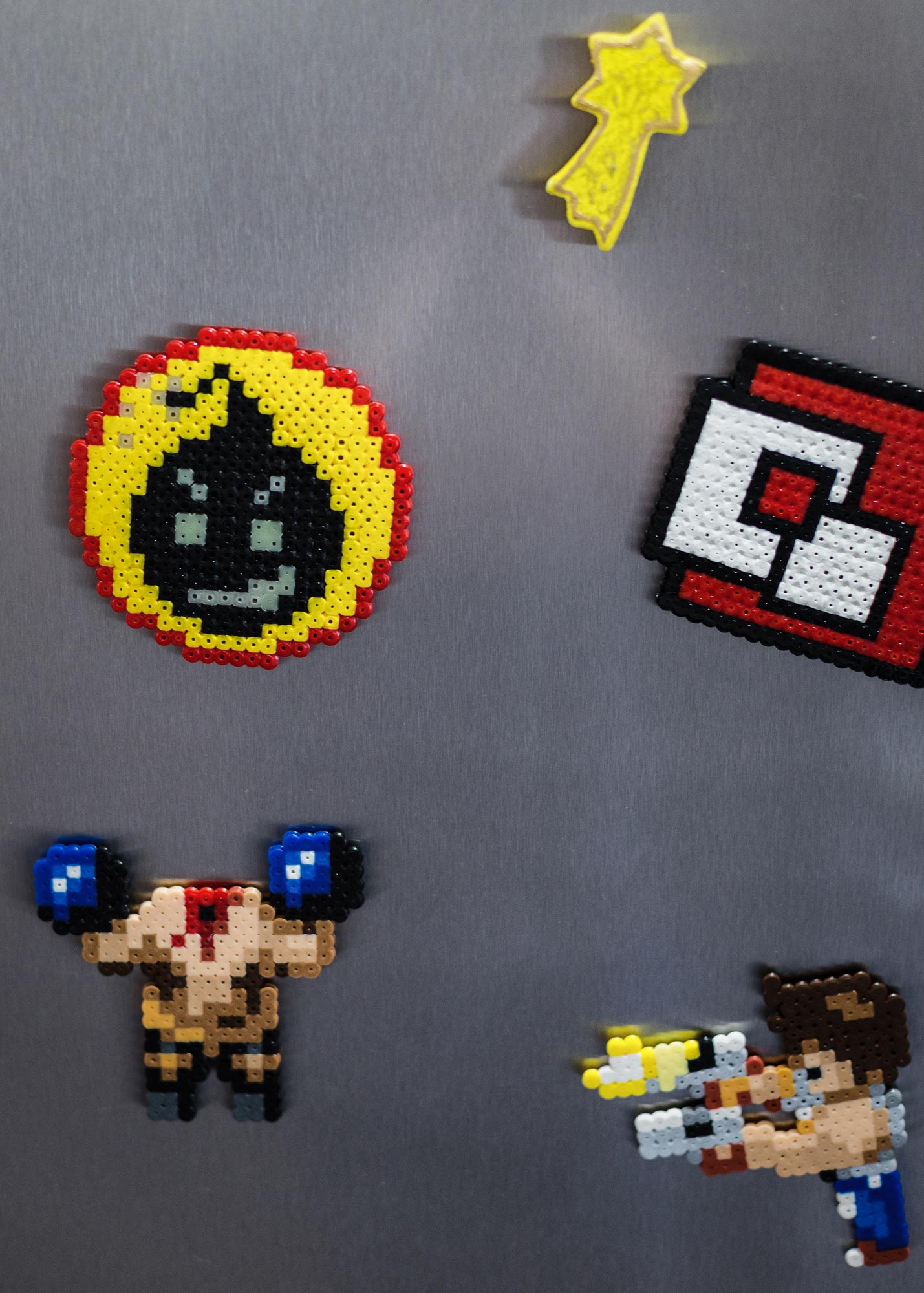 Even a refrigerator gets the Serious treatment
Even a refrigerator gets the Serious treatment
So, perhaps it’s no surprise that this is the studio pushing the VR envelope. Croteam has received significant media attention for going all-in on virtual reality, from re-releases of the first two Serious Sam titles to a completely new game, The Last Hope. Then there are promises of VR releases for Talos and Serious Sam 3. In parallel, they’re developing Serious Sam 4 and The Talos Principle 2—including, you guessed it, VR support. If you’re Croteam, VR offers no shortage of ways to stay busy. And, although the risks are often greater for indie developers, Croteam seems far more willing to experiment than their larger compatriots.
A Croatian (virtual) reality check
With all this emphasis on virtual reality, you might expect a robust Croatian VR scene with multiple startups, hackathons, and gaming cafes. Or, barring that, perhaps some other studios doing a bit of VR development on the side. But that’s not so: “The VR scene in Croatia is virtually nonexistent,” Ante Vrdelja tells me with a shrug. And he should know: besides his day job as a producer and CMO, he founded the Croatian Game Developer’s Association (CGDA), a networking organization for a Croatian game dev scene that’s only recently begun to thaw.
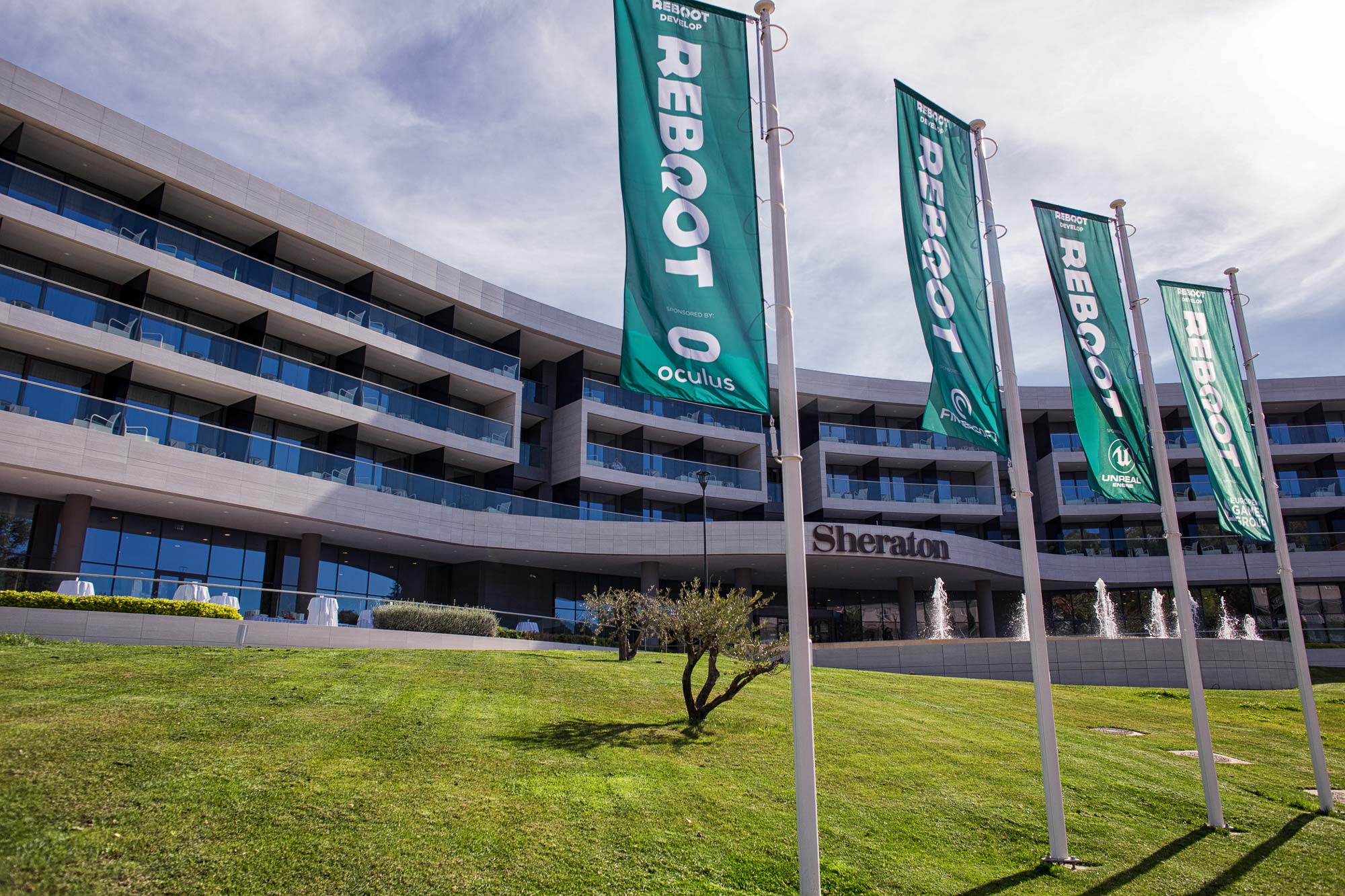 Flags flutter at the Sheraton Riviera where Reboot Develop is held, just a few minutes from the Dubrovnik old city.
Flags flutter at the Sheraton Riviera where Reboot Develop is held, just a few minutes from the Dubrovnik old city.
The problem? Whether you’re at the 70,000-attendee Reboot Infogamer expo in Zagreb—the biggest European consumer games expo besides Gamescom—or Reboot Dev, its industry counterpart, you’ll discover that Croteam is the only local studio investing in VR.
The challenge facing Croatian VR development is mirrored in other locales; for average consumers, headsets are simply too expensive. This is amplified when the average Croatian salary is just 5,716 kuna (812 US dollars) per month. With headsets costing anywhere from half to an entire month’s pay, it’s difficult to justify buying one, much less upgrading a PC to VR-ready specs. And in a country with few gaming cafes and even fewer shared VR spaces, it’s unlikely that many Croatian gamers have experienced VR outside of conventions like Infogamer or lower-cost platforms based on smartphones.
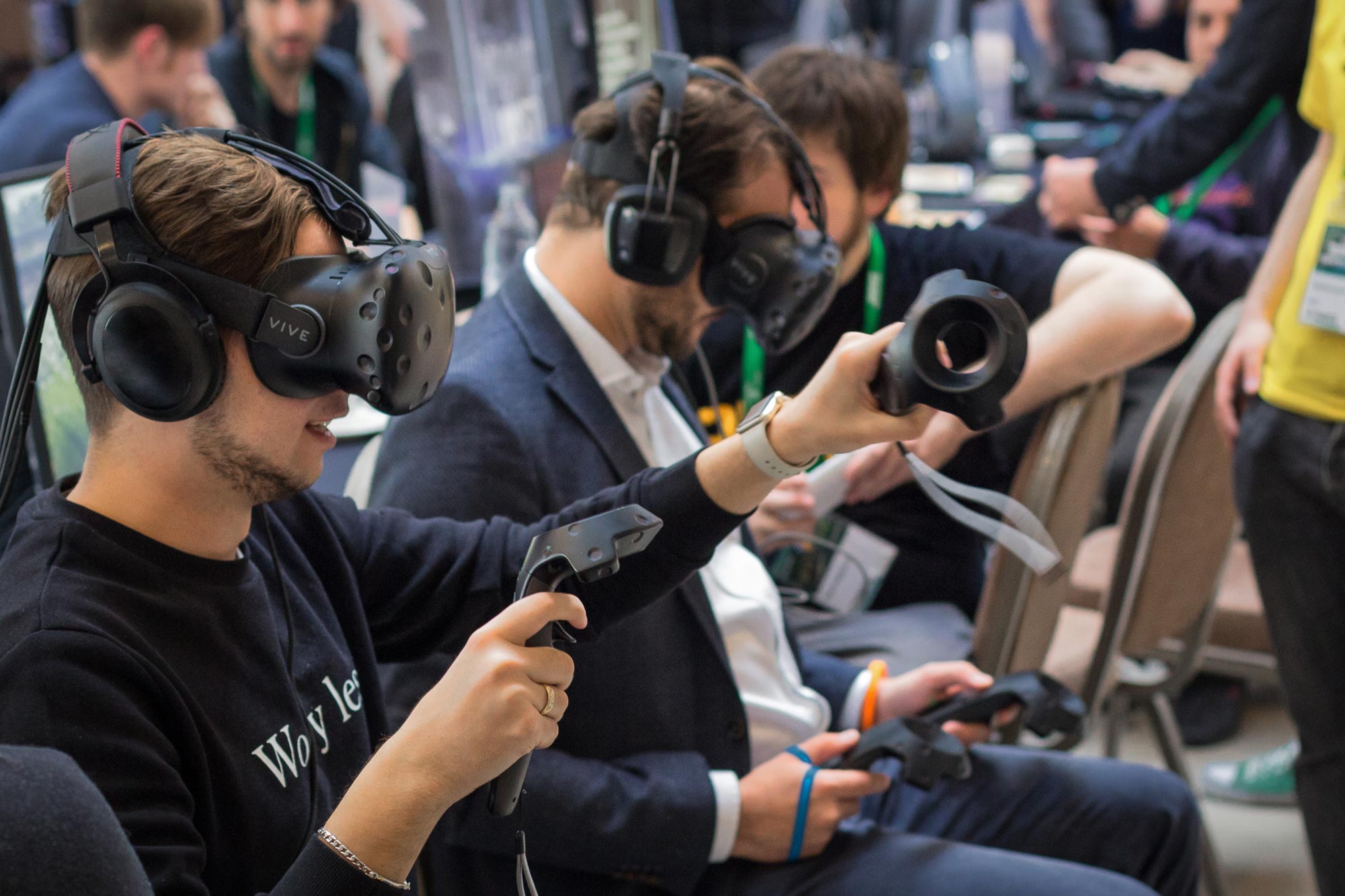 Users try VR at Reboot Develop 2017, potentially even for the first time.
Users try VR at Reboot Develop 2017, potentially even for the first time.
In spite of this, Croteam still wanted to be one of the first studios developing real VR experiences—not sandboxes, not experiments, and not one-off prototypes, but full games. Without a Croatian VR gaming market—and with research estimates pegging combined Rift and Vive purchases at about 663,000 consumer units worldwide—the question remains, why?
According to Vrdelja, the short answer is that it’s all about passion for tech and tinkering: “Croteam has always been a tech company, as [much] it is a games company. Simply put, we like to tinker with everything that we can get our hands on.” And it’s true—Croteam’s experimentation is evident almost everywhere, from the Serious Engine, cross-platform support for Tegra tablets and SteamBox, early adoption of the Vulkan API, experiments with mixed reality, and even multiple VR locomotion methods. So far, this passion hasn’t led them astray.
No one said it would be easy, but…
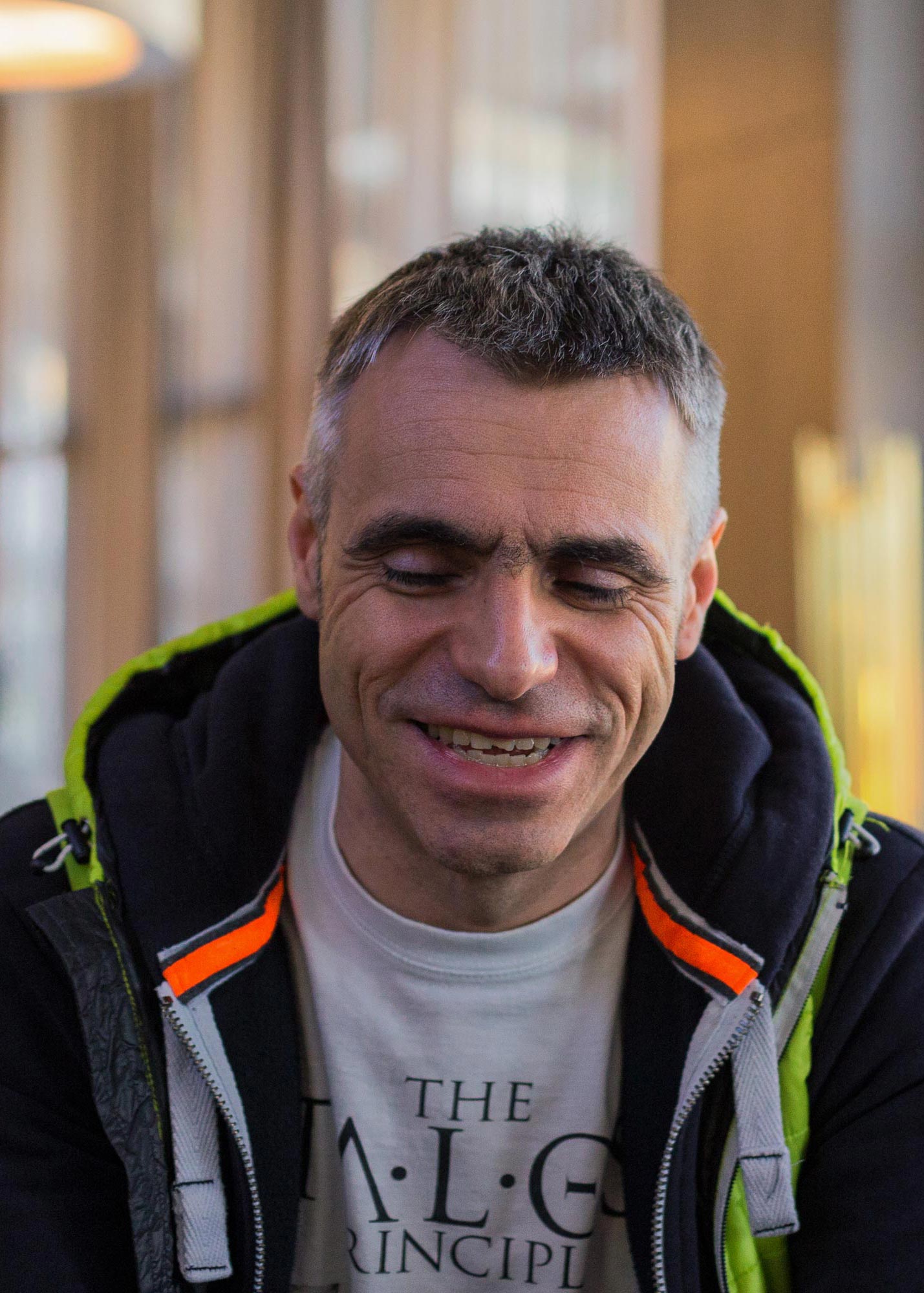 Alen Ladavac recalls the many challenges of adapting traditional games to VR
Alen Ladavac recalls the many challenges of adapting traditional games to VR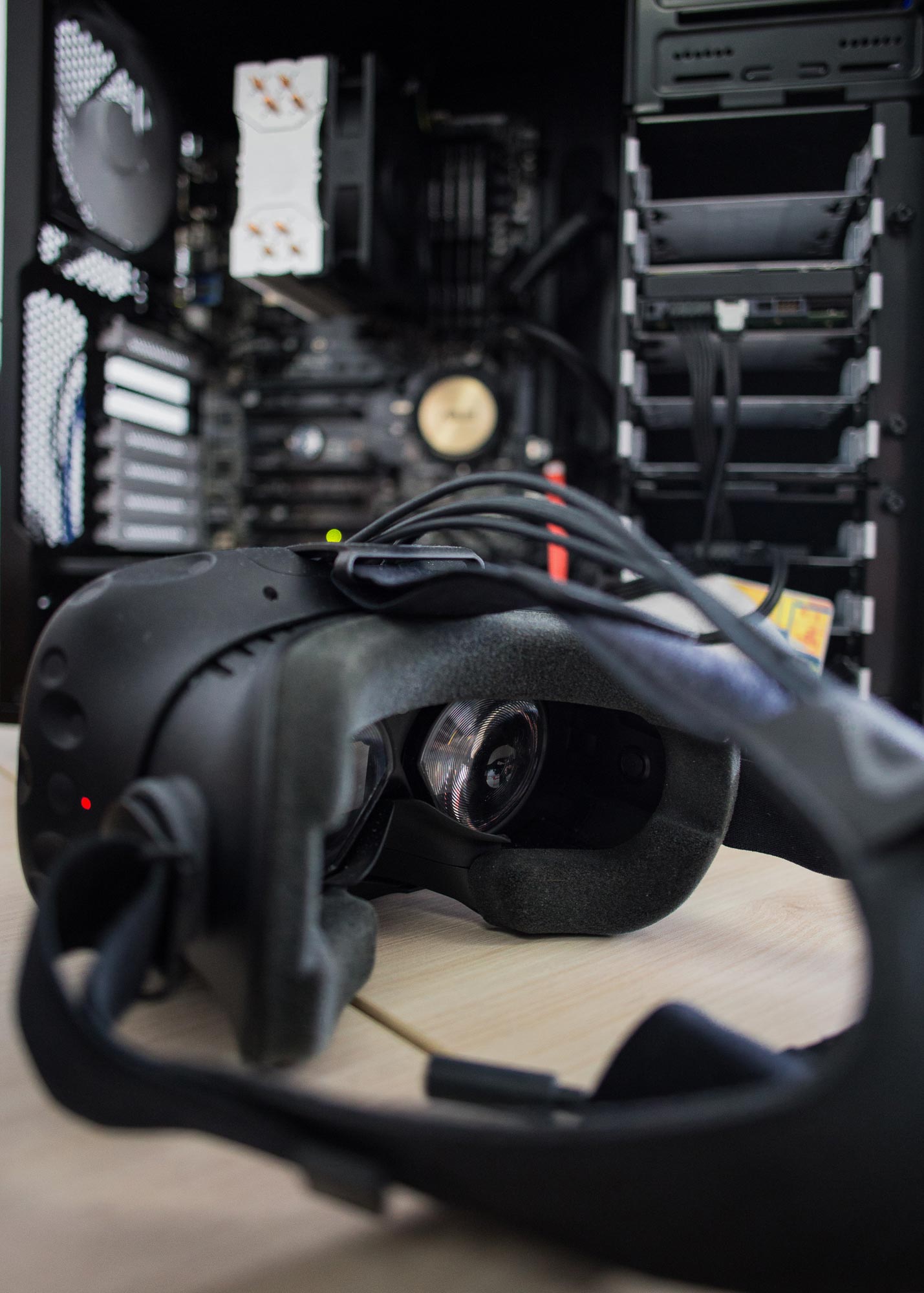 An HTC Vive attached to a Croteam dev machine
An HTC Vive attached to a Croteam dev machine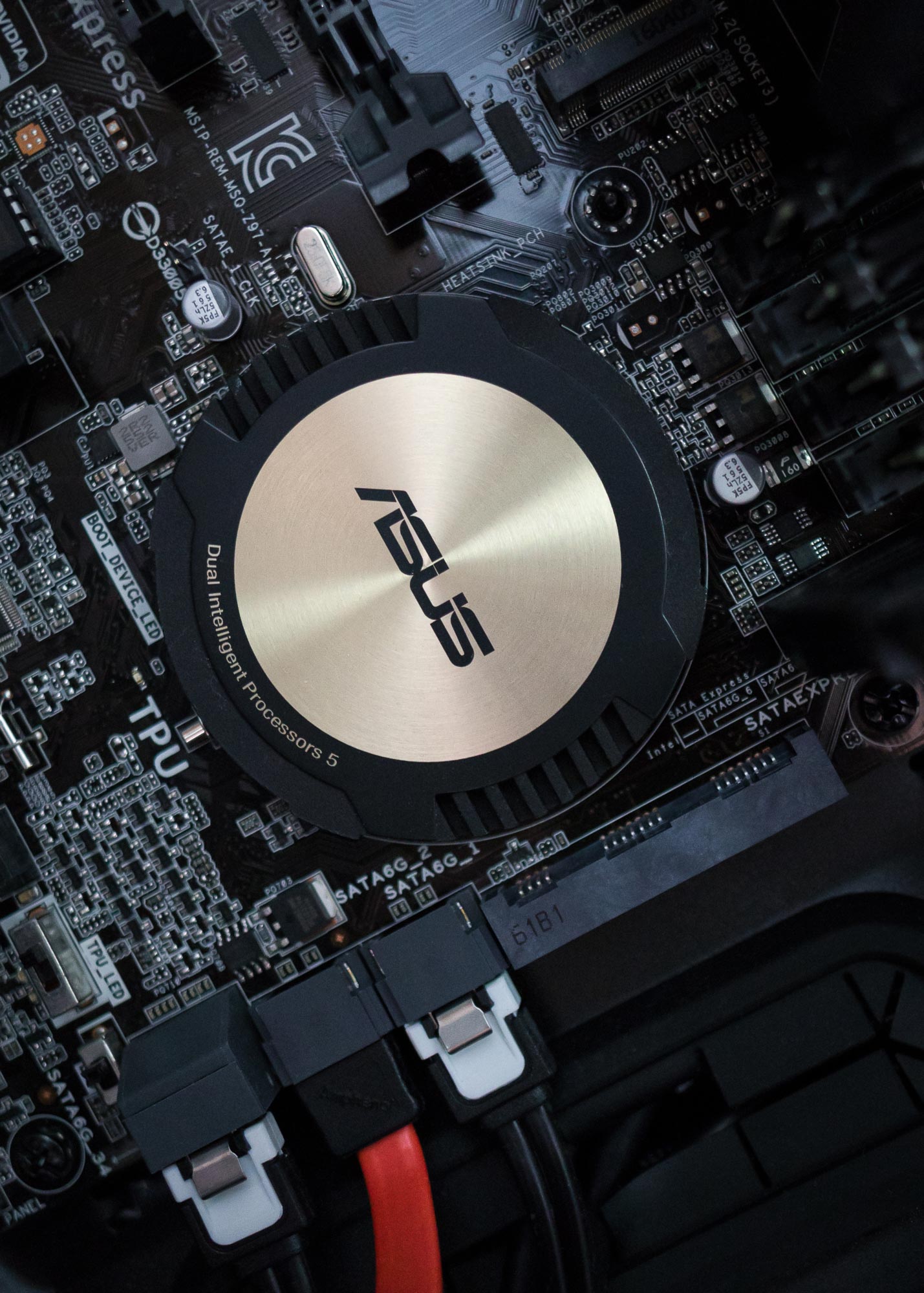 Many of Croteam’s dev boxes use ASUS hardware, including motherboards
Many of Croteam’s dev boxes use ASUS hardware, including motherboards
Croteam’s fast-talking CTO Alen Ladavac leans toward me in a white Talos t-shirt, his face animated under serious eyebrows. “We [always] get this comment from users: ‘why do you want to charge so much for a VR game?’ [But] it’s this huge amount of work that they don’t see.”
When Croteam first dipped a toe into VR development, they also thought it would be simple. It all began with a basic port of Serious Sam: The First Encounter. Get the VR APIs working, render the game in stereo, put a gun in the player’s virtual hands, and give it a whirl.
“And we immediately realized, ‘Wow, this sucks.’” Ladavac laughs and shakes his head in dismay. He recalls the laundry list of VR-specific bugs as a veritable “endless sea of things to do.” They would solve the first set of issues only to discover new ones, like peeling back the layers of an onion.
Mechanics that worked well for traditional games were terrible in VR—things you wouldn’t expect, like gun recoil, jump-pads, and low gravity. The user’s VR hands just didn’t work well with recoil. But get rid of recoil entirely, and certain weapons became too powerful. Jump-pads—devices that launch players high into the air—and low gravity made VR users sick. There were so many elements clashing with VR that it had to be special-cased in the game code, with weapons rebalanced and entire levels redesigned.
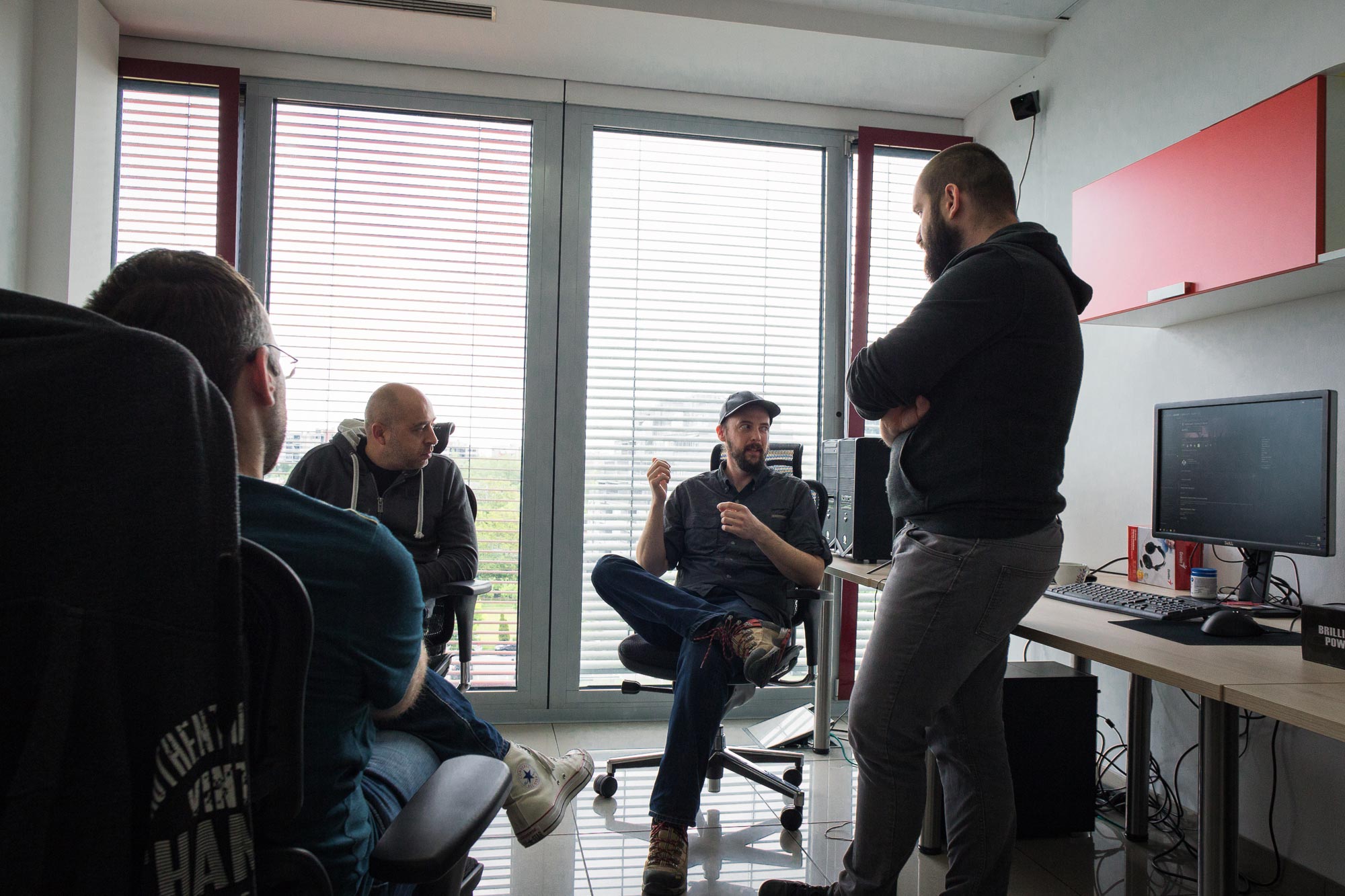 Planning their next move: Marketers, designers, and developers chat in one of Croteam’s shared office spaces.
Planning their next move: Marketers, designers, and developers chat in one of Croteam’s shared office spaces.
Adding locomotion methods like teleportation opens an entirely new can of worms, from enemy AI to game physics. In the traditional game, extra-tough enemy AI is designed to shoot running and dodging players as soon as they come to a stop. In VR, this means teleporting players were shot as soon as their teleport completed, as if the enemy had predicted their destination through some sixth sense.
And with event triggers, if a player teleported through a doorway or other world element, the physics engine needed to run extremely quickly. In fact, it needed to run in the timespan between two frames being drawn onscreen.
No one said it would be easy, but until they tried, not even Croteam realized quite how difficult implementing VR in a pre-existing game would be.
Off to see the wizard
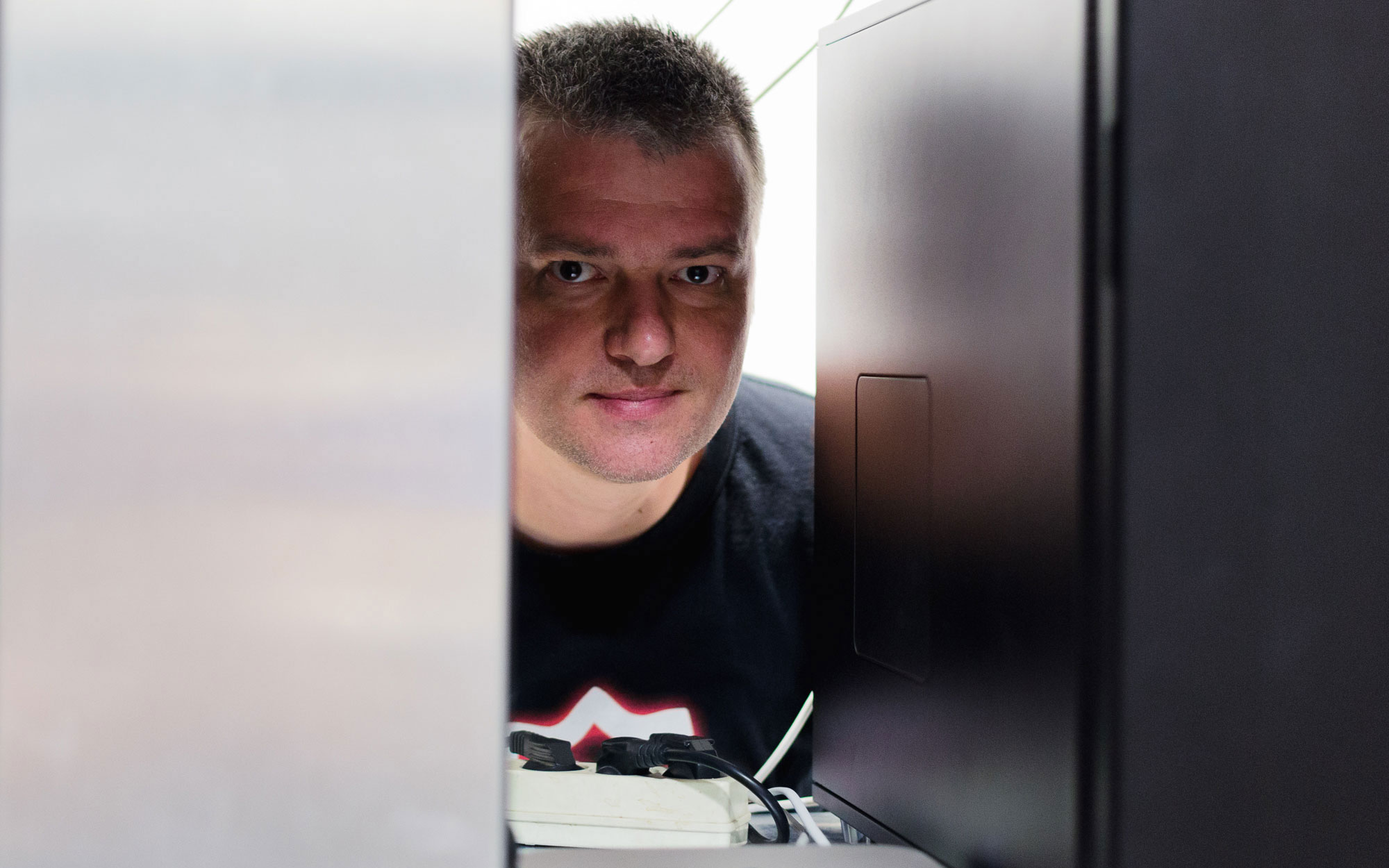 Right at home: GPU wizard Dean Sekulić peers out from one of his natural habitats—the Croteam server room full of custom-built PCs
Right at home: GPU wizard Dean Sekulić peers out from one of his natural habitats—the Croteam server room full of custom-built PCs
These aren’t the only challenges Croteam faced with VR. Co-founder Dean Sekulić was the first person in the world to implement the Vulkan API. Widely known as a “GPU wizard,” he’s also a senior programmer with firsthand experience in the woes of early adoption. Around GDC 2016, the Vulkan API was especially in flux. “At that time it was a moving target,” he says, recalling their many frustrations. “You’d implement something, then you’d need to throw it away and implement it [another] way.”
There are definite benefits to early involvement. Croteam is on the Vulkan Advisory Panel, so they can influence design decisions. But it’s also a lot of work. Croteam’s Vulkan integration began seven months before Vulkan v1.0’s public release. It’s now been over a year, and they still have another year’s work ahead, including plans for native, multi-threaded rendering.
Serious Engine 2017, Croteam’s latest proprietary game engine, is the first version that officially supports the Vulkan API. Although they provided early v1.0 support in a February 2016 Talos beta, this was just a proof-of-concept. Their engine was originally designed for OpenGL 2.1 and DirectX 9; switching to an API with a new, low-level programming model was no simple task.
Sekulić’s tireless work bringing Vulkan to the Serious Engine is part of what makes Serious Sam run so seamlessly in VR.
Sekulić is now almost 100% sold on Vulkan, particularly its performance enhancements, cross-platform capabilities, and native support for simplified VR rendering. For example, Vulkan renders scenes just once instead of twice (one time for each eye). This offers especially significant performance savings. And, although DirectX 11 and 12 offer extensions with similar benefits, Sekulić finds Vulkan to be more straightforward and believes the performance gains are greater.
According to Sekulić, the best is yet to come. His face lights up as he describes their plans; his excitement about performance optimizations is contagious. Croteam’s ultimate goal is super-smooth and ultra-seamless PC gameplay, and he thinks Vulkan can someday deliver framerate consistency as fine-tuned as consoles. Explicit, low-level APIs already provide far greater performance opportunities. But if Vulkan incorporates display frametime reporting, the Serious Engine can heuristically adapt to frame timing changes, providing an even better experience. Lofty goals? Perhaps. But, then again, they do call him the GPU wizard.
Seriously amazing
“Are you ready to try some Serious Sam in virtual reality?” Ante Vrdelja grins at me as we enter the shared office space where Wolf, one of Croteam’s developers, has my ROG Strix GL502VS gaming laptop set up with an HTC Vive and Steam VR.
I don the headset, they place the Vive wands in my hands, and suddenly I find myself in a torchlit, red-tinged Mesoamerican temple fighting off clusters of clawed Kleer Skeletons and dodging crushing death from moving floors.
I’m impressed: even The Second Encounter’s older graphics look good in VR. They’re certainly convincing enough to be immersive, and they play very well on the GL502VS. And teleportation feels quick and nimble thanks to Croteam’s clever input design—tapping the Vive trackpad teleports a set distance, while pressing and holding provides precise teleportation beacon placement. This differs from many other VR games, which often rely solely on beacon placement, forcing you to always choose a distance before teleporting. For fast escape from enemies during a firefight or speedy navigation around a level, this quick tap-tap-tap teleportation style works extremely well.
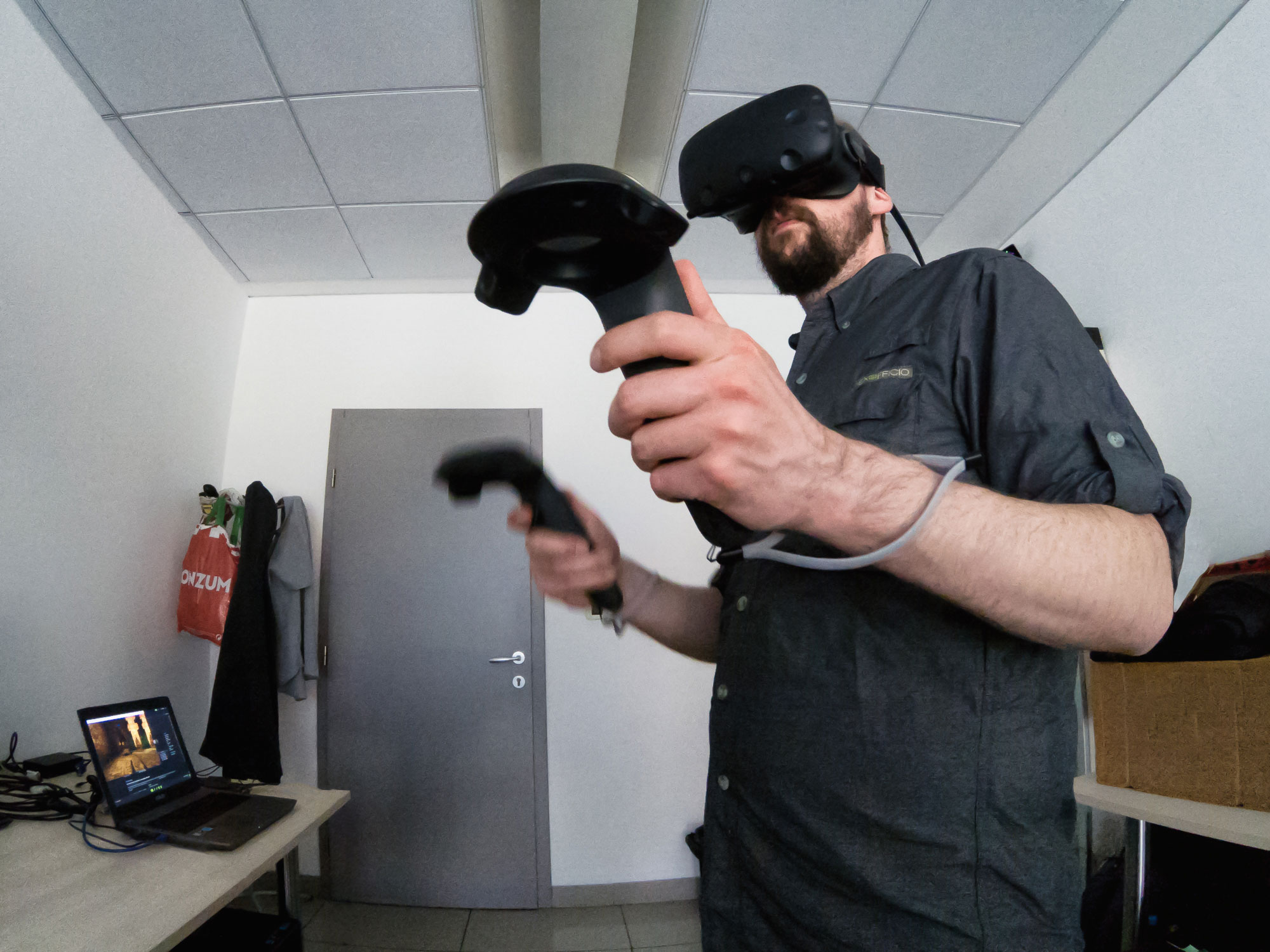 Getting into it: Playing Serious Sam VR on the GL502VS is so seamless that you forget you’re on a laptop.
Getting into it: Playing Serious Sam VR on the GL502VS is so seamless that you forget you’re on a laptop.
We switch over to Serious Sam: The Last Hope. This is Croteam’s first made-for-VR title: an arcade-style wave shooter with a 180-degree perspective—no locomotion, just Sam blasting massive hordes of enemies, some as tall as skyscrapers, in one place. After choosing “normal” difficulty, I’m dropped into the first Earth level, “Monolith of Time,” set somewhere in an imaginary Egyptian desert. The wide-angle view is centered on an obelisk framed by palm trees, stone mesas, and a dusky sky. I select dual pistols and look out at the scene, thinking, however fleetingly, that this desert panorama could almost be relaxing. Almost.
And then the onslaught begins.
Zorg in the middle; Zorg on the left. Antaresian spider scuttling in, but—quick, Harpy in the sky! Wait, where did that caustic goo come from? Left fireball, right trigger; right fireball, left trigger—blast them out of the air, arms crisscrossing, no time to readjust. A Kamikaze comes screaming in from the center and I shoot with both pistols, index fingers pumping furiously, squeezing out laser rounds as quickly as possible. He explodes, showering gory chunks from what feels like mere feet away. I don’t notice or miss the lack of weapon recoil. When I die, my hands are sore from tightly clutching the wands and rapidly pulling the triggers; my shoulders are tired from holding out my arms. That was intense. Fatigue be damned, I play at least ten more rounds. The headset only comes off when Croteam employees begin packing up to go home.
Watch: Ante Vrdelja and level designer Nika talk Serious Sam: The Last Hope with Shacknews at E3 2016
“So, what did you think?” Vrdelja asks me, grinning.
“That was awesome!” Everything ran so smoothly, I forgot I was playing VR on a laptop until I removed the Vive. In fact, the GL502VS’s performance easily beat my beefy, VR-ready desktop. The graphics looked amazing, the gameplay was flawless, there was no disorientation—it was just frantic FPS goodness. Even the soundtrack perfectly fit the game, thanks to long-time composer Damjan Mravunac’s intense attention to detail.
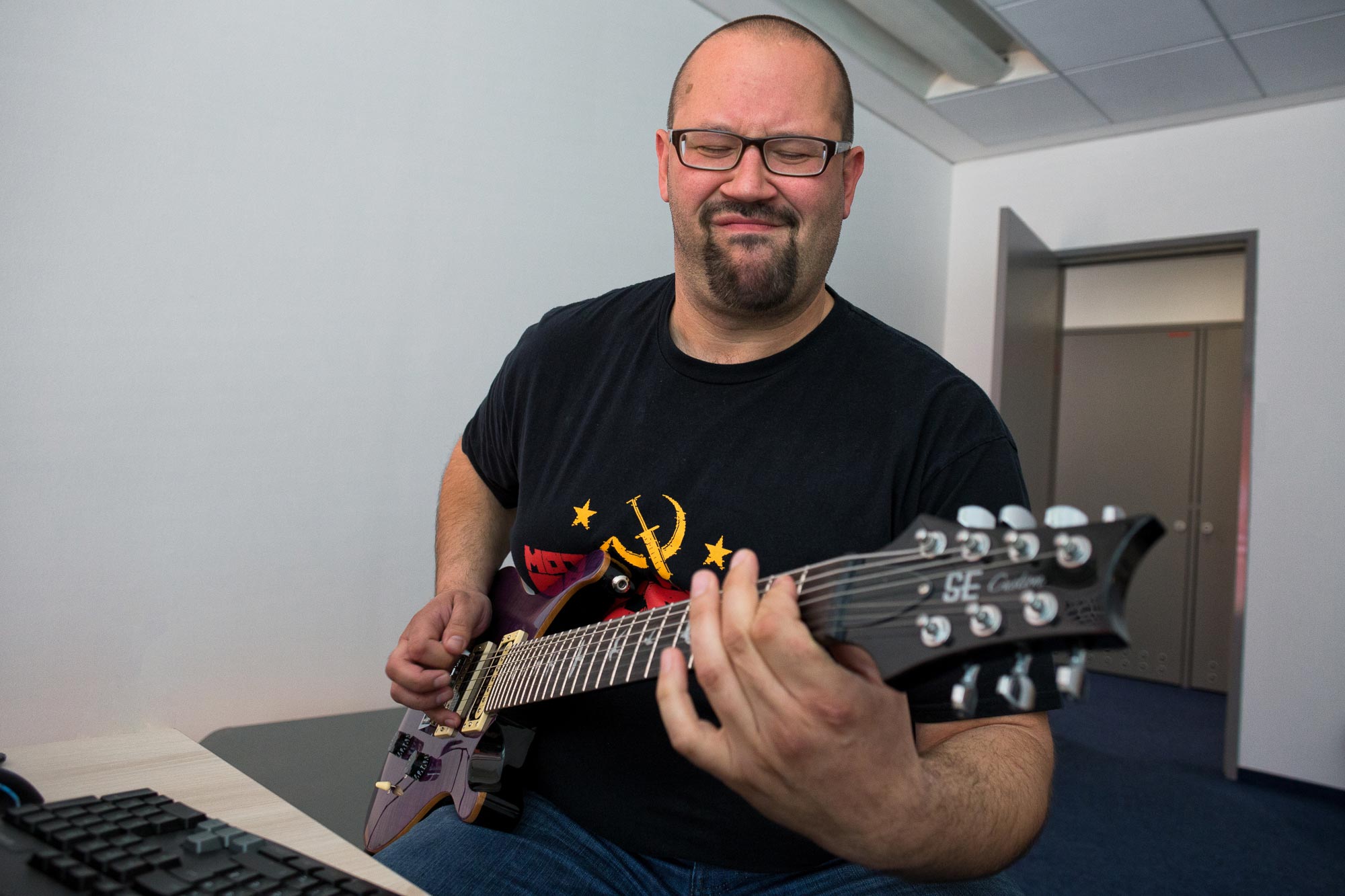 Serious talent: Mravunac composes and plays the score for every Croteam game.
Serious talent: Mravunac composes and plays the score for every Croteam game.
Vrdelja grins again and nods, but doesn’t look surprised. For him, a favorite part of conventions is seeing people try VR. “I’ve probably shown our games to hundreds or even thousands of people,” he tells me. “They strap on the headset for the first time. They play the game for 10 minutes or so, and they’re totally amazed.”
So, of course he already knew the answer to that question.
The best is yet to come
Onstage at the Reboot Dev keynote, Alen Ladavac poses a question: how many industry professionals in the audience are working on VR?
The majority of hands stay down. Nervous laughter cascades through the crowd.
He nods, as if confirming a known fact. New question: “Okay, and how many of you have tried a real VR experience—Vive or Rift?”
More hands go up this time, but still shy of a majority. Even I’m surprised by this.
 At Reboot Dev, Ladavac asked how many developers were working with VR. Surprisingly, the answer was not many.
At Reboot Dev, Ladavac asked how many developers were working with VR. Surprisingly, the answer was not many.
Ladavac likens VR to early films, when audiences actually thought a train was coming at them—except today’s immersion is so complete that players fall over during billiards when they try leaning on nonexistent tables. It’s only now that the technology has become truly, convincingly immersive. “Humans have never before experienced the ability for a computer-generated image to evoke the response that you’re somewhere else,” he says. To him, this is the magic of today’s VR.
Ask the other Croteam founders and employees what’s most exciting about VR, and their responses are similar. But beyond this, they don’t feel it’s being given a fair chance. With overzealous media reporting that VR is either a fad or a failure, there’s more desire than ever to disprove those claims. Croteam has seen enough naysayers converted after simply trying the tech. They believe if words don’t do it justice, only first-hand experience can.
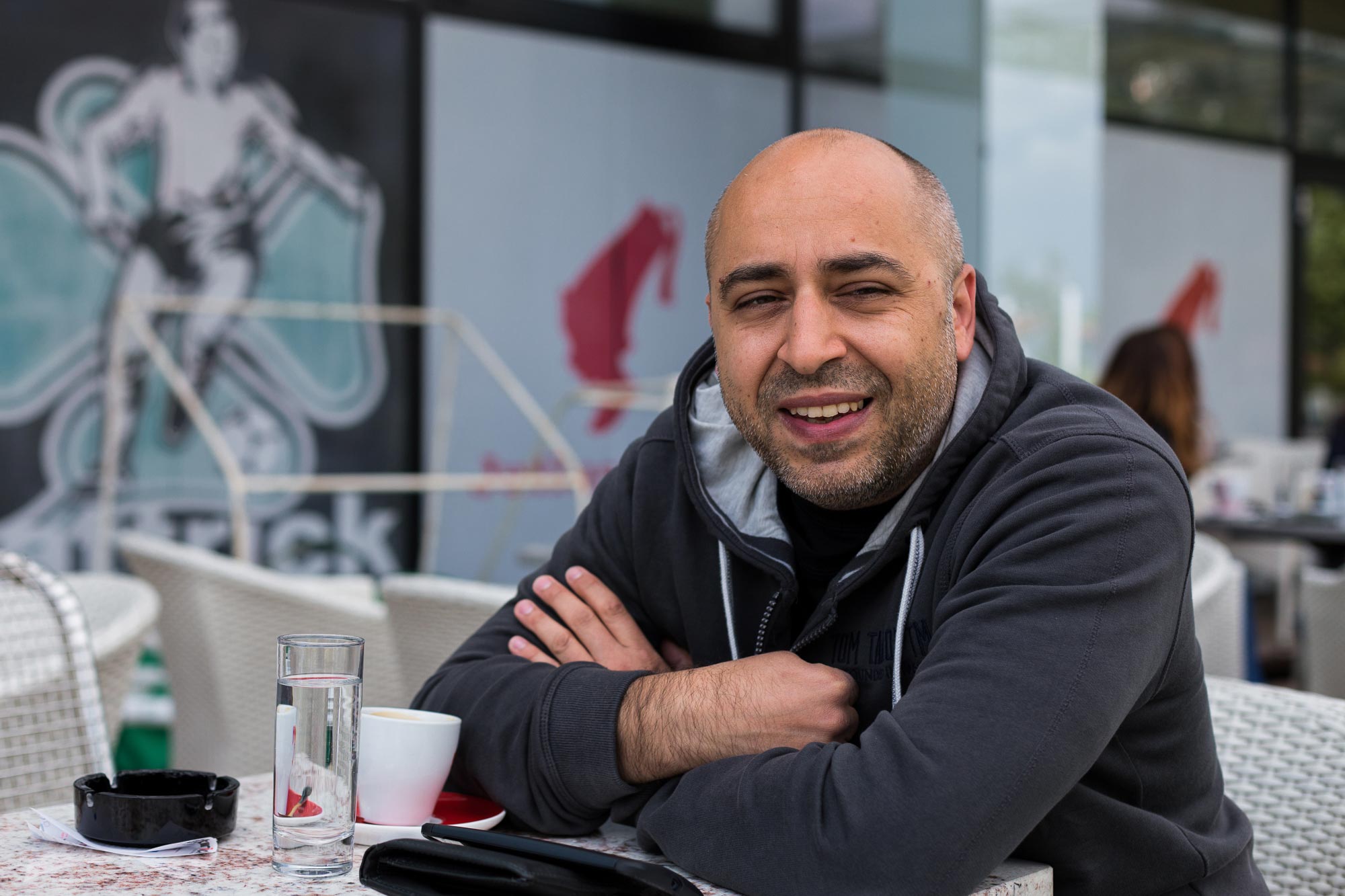 CMO Ante Vrdelja stresses the importance of patience with the VR industry’s sometimes-slow pace
CMO Ante Vrdelja stresses the importance of patience with the VR industry’s sometimes-slow pace
Over an extended Croatian coffee break, Vrdelja makes a plea for patience. “I think that we need to take a step back and [realize] it’s only been here really for a year,” he says. “It’s basically a Holodeck in your living room. It’s amazing. Tech is still being developed and [game] titles may be coming out slowly, but they’re coming.” In short: give it time.
While other developers have hung back, Croteam’s VR enthusiasm is clear. As far as they’re concerned, the best is yet to come—and, no matter what it takes, they’re determined to be a part of that future.
By Kimberly Koenig
Author
Popular Posts

How to adjust your laptop's P-Cores and E-Cores for better performance and battery life
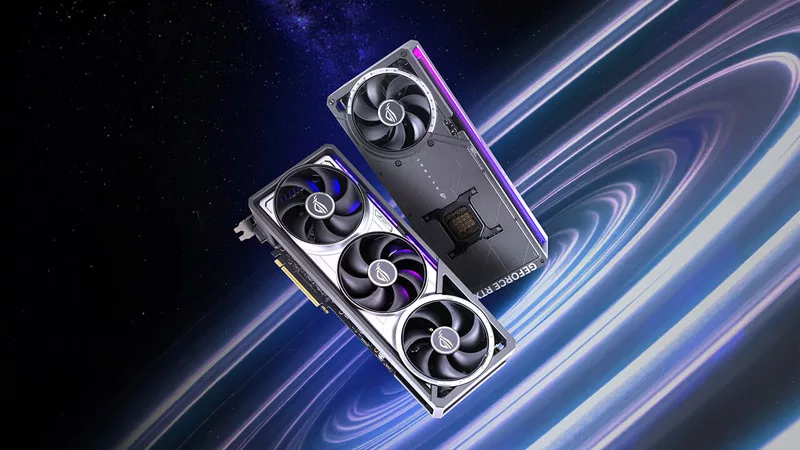
Introducing the ROG Astral GeForce RTX 5090 and 5080: a new frontier of gaming graphics
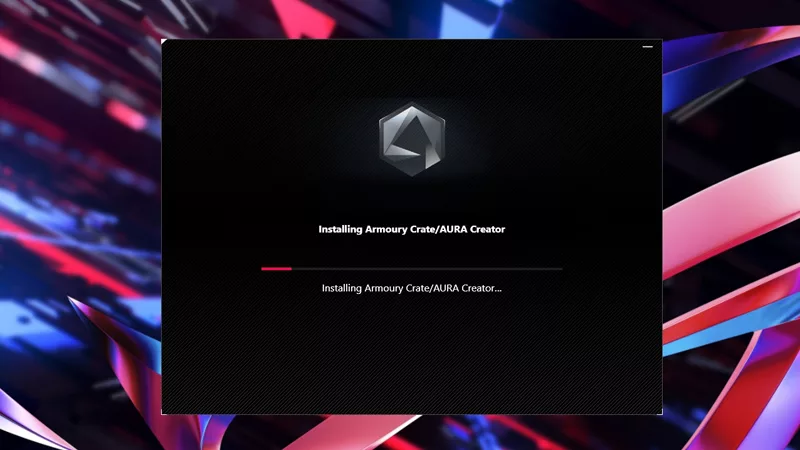
How to Cleanly Uninstall and Reinstall Armoury Crate
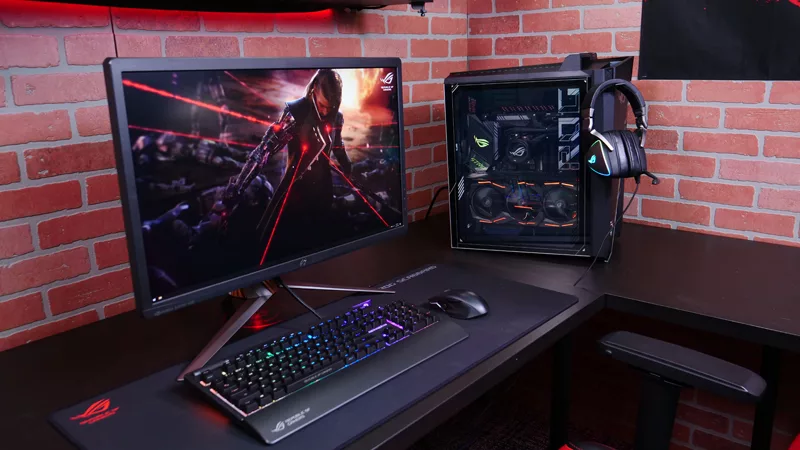
How to configure your PC's RGB lighting with Aura Sync
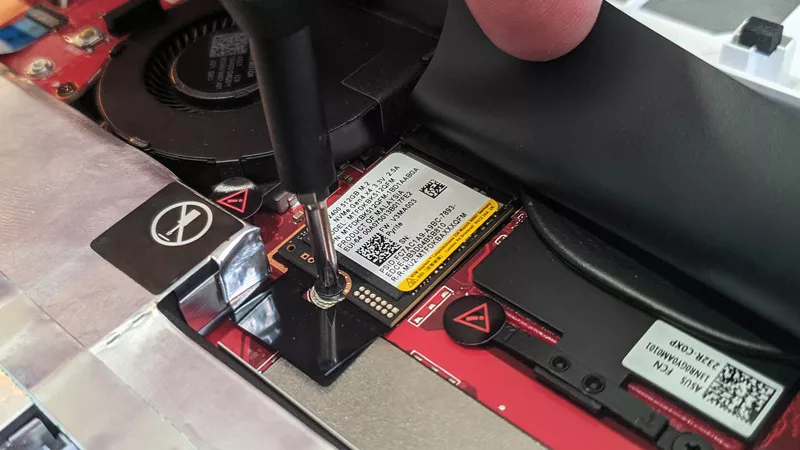
How to upgrade the SSD and reinstall Windows on your ROG Ally or Ally X
LATEST ARTICLES
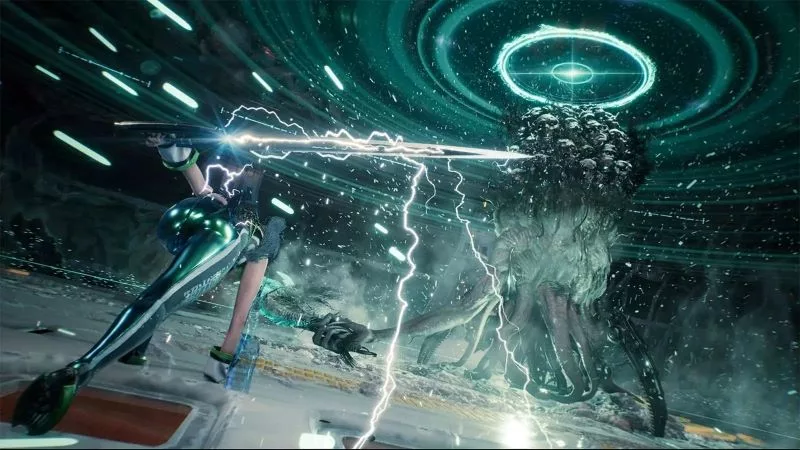
Stellar Blade is the stylish, stimulating action romp PC gaming needed in 2025
It’s one thing to look good, it’s another to play well, and it’s a Herculean task to deliver a game that manages both. But Stellar Blade does the job with gusto.
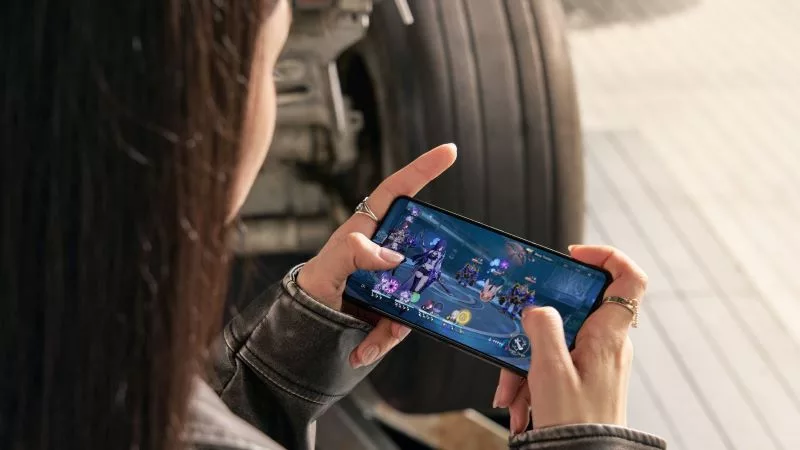
10 must-play ROG Phone 9 games with support for Game Genie and AI features
From FPS to immersive RPGs, check out the best games to play on the AI-enhanced ROG Phone 9 series.
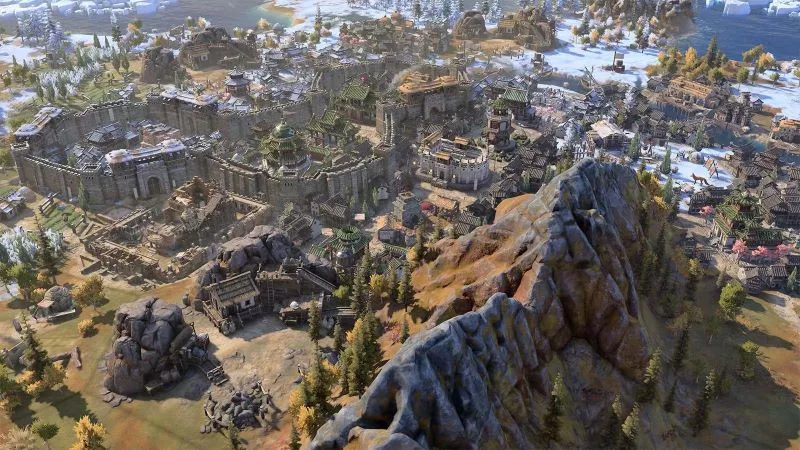
The best laptop-friendly PC games you can play without any peripherals
If you want to game on the go without dragging a mouse or controller with you, don’t worry: there’s plenty you can play with just your laptop’s built-in keyboard and trackpad.
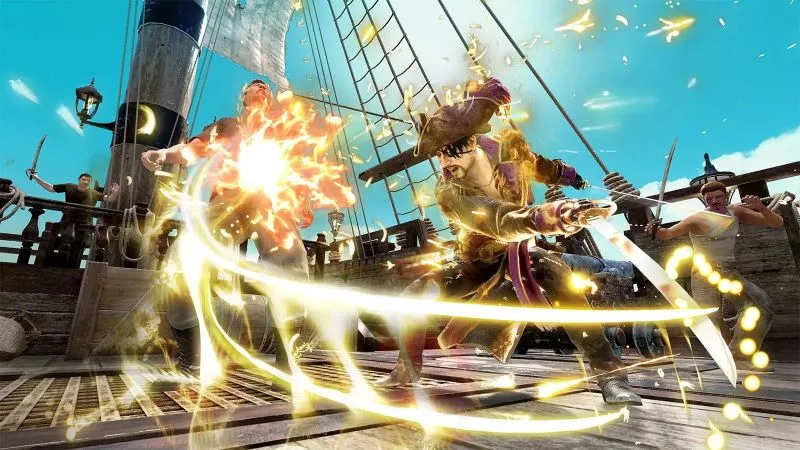
Like a Dragon: Pirate Yakuza in Hawaii is absurdist gaming at its finest
Like a Dragon games are playable versions of weird stories a quirky friend might share over coffee. Like a Dragon: Pirate Yakuza in Hawaii is no exception.
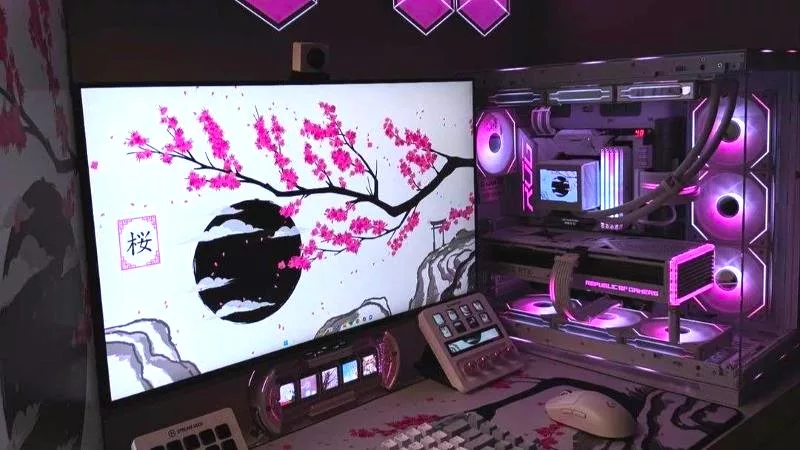
Four insane ROG PC gaming battlestations you need to see to believe
Expressing your personality with a tricked-out gaming setup is a core part of the PC gaming experience. No one knows this better than ROG loyalists, who produce some of the wildest battlestations on the planet.
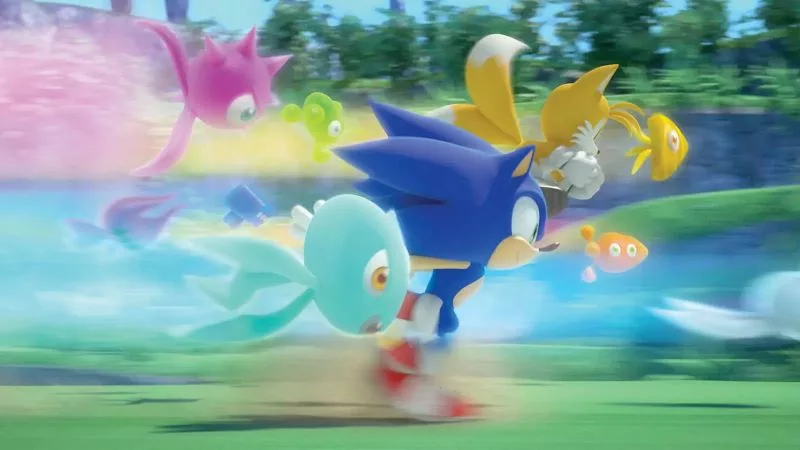
Why Sonic the Hedgehog is the wildest series in gaming
If you’ve been gaming for a while, you probably know SEGA’s Sonic the Hedgehog. But do you know why he commands his own gravitational orbit among a dedicated group of fans?
